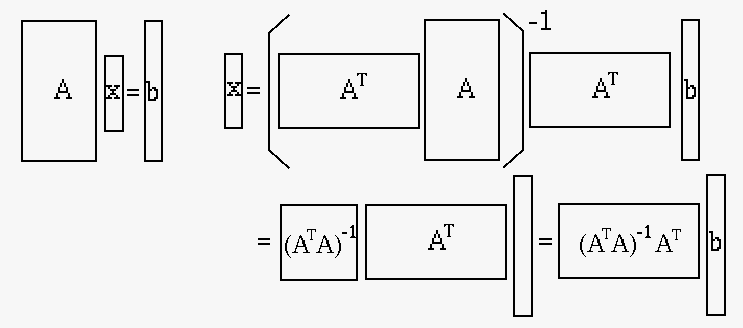Next: The Bisection and Secant Up: Solving Equations Previous: Solving Equations
Consider a linear equation system of 

 |
(1) |
 |
(2) |
![$\displaystyle {\bf A}=\left[\begin{array}{ccc}
a_{11} & \cdots & a_{1N}\\ \vdot...
...\;\;\;\;\;\;
{\bf b}=\left[\begin{array}{c}b_1\\ \vdots\\ b_M\end{array}\right]$](img43.svg) |
(3) |
 can be determined by the
fundamental theorem of linear algebra
based on the rank
can be determined by the
fundamental theorem of linear algebra
based on the rank  of the coefficient matrix
of the coefficient matrix
 . Here we only consider some speical cases:
. Here we only consider some speical cases:
 ,
,  is full rank square matrix, and
its inverse
is full rank square matrix, and
its inverse
 exists. Then the system has a
unique solution:
exists. Then the system has a
unique solution:
 |
(4) |
 , the system is under-determined or under-constrained
and there may exist multiple solutions.
, the system is under-determined or under-constrained
and there may exist multiple solutions.
 , the system is over-determined or over-constrained
and no solution exists. However, we can still find the optimal
solution in the least-squares sense.
, the system is over-determined or over-constrained
and no solution exists. However, we can still find the optimal
solution in the least-squares sense.
We now consider solving the over-determined linear system in
last case. The error or residual of the ith equation
is defined as


![${\bf r}=[r_1,\cdots,r_M]^T$](img54.svg)
 |
 |
 |
|
 |
 |
(5) |
To find the optimal solution 


 |
 |
 |
|
 |
 |
(6) |
 is the pseudo-inverse
of the non-square matrix
is the pseudo-inverse
of the non-square matrix  .
.

When the 



This problem can be addressed by regularization.
Specificaly, by which the solution 


 |
(8) |
 , we can obtain a solution
, we can obtain a solution
 of small norm
of small norm
 as well as low error
as well as low error
 . Same as before, the solution
. Same as before, the solution  can be obtained by setting the derivative of
can be obtained by setting the derivative of
 to
zero
to
zero
 |
(9) |
 |
(10) |
 is near singular,
matrix
is near singular,
matrix
 is not due to the
additional term
is not due to the
additional term
 .
.
By adjusting the hyperparameter 
 : the solution is more accurate but
also more prone to noise and therefore less stable,
i.e., the variance error may be large. This is called
overfitting;
: the solution is more accurate but
also more prone to noise and therefore less stable,
i.e., the variance error may be large. This is called
overfitting;
 : the solution is more stable as it
is less affacted by noise, but it may be less accurate.
This is called underfitting.
: the solution is more stable as it
is less affacted by noise, but it may be less accurate.
This is called underfitting.